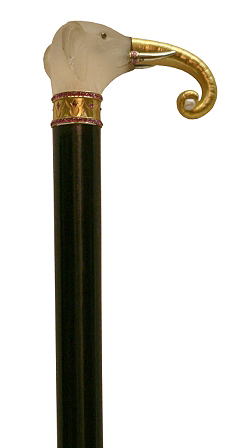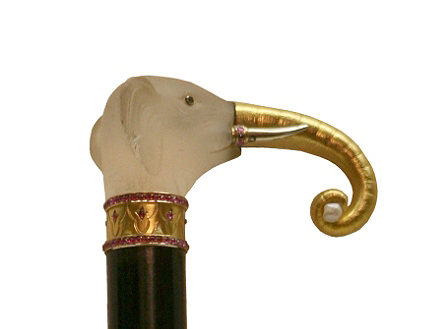The piece of the month of August 2013
A CANE FROM THE FABERGÉ HOUSE OF THE VIOLINIST PABLO SARASTE IN THE COLLECTION OF THE PAMPLONA TOWN HALL
Ignacio Miguéliz Valcarlos
Chair of Navarrese Heritage and Art
Pablo Sarasate (1844-1908) is one of the great figures of music not only in Navarre but also in Spain and the world. He studied at programs of study in Pamplona, Pontevedra, Madrid and Paris, with scholarships from the Countess widow of Espoz y Mina and Queen Isabella II, among others. degree program In 1857 he obtained the first violin award from the Paris Conservatoire, which marked the beginning of a brilliant career as a concert pianist which led him to play in the best concert halls in Europe and America. Throughout his career he received gifts from numerous admirers, including not only royalty, such as the queens of Spain and England and the Empress of Germany, or aristocracy, such as Princess Metternich, Baron Rothschild and General Schouvaloff, but also from governments all over the world and anonymous personalities. Many of these gifts were in the form of jewellery, including rings, tie pins, watches, cigarette cases and walking sticks, most of which were bequeathed by the artist, along with other pieces, to Pamplona City Council for display in the museum that the Pamplona regiment planned to dedicate to its illustrious countryman.
However, despite possessing all this jewellery, Sarasate was a man of great austerity and did not usually make use of them, except for the walking sticks, of which he assembled a varied collection, part of which, fourteen pieces, considered to be the richest works, he donated to Pamplona City Council between 1905 and 1906. The walking stick was a very important male accessory, used since Antiquity, where it was employee in a utilitarian way as a support for walking and as a defensive weapon, going on to become an element of power as a baton of command, with a symbolism linked to the authority and power of the bearer. During the Modern Age this piece maintained its relationship with power, being used as a baton of command by civilians and soldiers, as well as appearing as a sign of distinction in the privileged classes, and it was common to see this accessory in male portraits together with the sword. It was not until the twentieth century that the use of the latter was relegated to the background in men's clothing, while the cane acquired greater importance as an indispensable accessory for the gentleman, especially during the Belle Époque, as this accessory, as important as the hat, was used not only for support, but also to enhance the elegance and refinement of the person who carried it. But the peculiarity of these accessories was centred on their handles, which could range from the most modest, made from the same wood as the cane, to the richest, made from rich materials such as gold, silver, ivory or precious stones, some of which were described as extravagant, with the inclusion of hard stones and whimsical shapes. All the great jewellery houses of the time, Fabergé, Cartier, Tiffany, Falize, Lalique, Ansorena, etc., made pieces of this type subject, which had their parallel in women's fashion in the handles of parasols and parasols.

Cane of Pablo Sarasate
(file Municipal de Pamplona)
Given Sarasate's reputation for austerity and his interest in canes, his admirers soon began to present him with this subject of works. They found out about his predilection for good canes, and they all gave them to him in abundance issue and of excellent quality. In this way Sarasate soon found himself with a very valuable and artistic collection of canes, which is famous in Spain and abroad. It is the gift he accepted most willingly and used the most. His priceless collection included walking sticks of all kinds and from all countries. Sarasate assembled an important collection of these works, some of which were made by prestigious European and American jewellers, such as Fabergé, Cartier, Tiffany's and Ansorena. His walking sticks range from simple pieces for everyday use to richer ones, with handles made from rich materials such as silver and gold and precious stones.
Among the walking sticks bequeathed by Sarasate to the Town Hall is one with a handle in the shape of an elephant's head, measuring 88 cm long at the shaft, 8 cm on each side and 4 cm deep at the handle, made of wood, rock crystal, yellow gold and gemstones. It fits a variant with an arched hilt, a classic finish consisting of a curved upper part. It has a lacquered wooden shaft with a truncated cone-shaped tip between mouldings, and a hilt in the shape of an elephant's head, carved from a piece of rock-crystal, which sits on a cylindrical yellow-gold ferrule with vegetal decoration incised between two moulded borders inscribed with a band of cabochon rubies. The elephant's eyes are made of emeralds, while the trunk is carved in hammered gold, curling around a natural pearl at the nose. Framing the horn are two tusks made of silver in the same colour. The wooden box of this piece is also preserved, lined on the outside with red leather and on the inside with white satin, on which is inscribed in gilt letters, under the Russian Imperial coat of arms, the name and address of the house of Fabergé in Cyrillic script 'Fabergé. St. Petersburg. Moscow'. It also has a red silk support on which sits a silver plate in the same colour on which is engraved the following registration "To Mr. Pablo Sarasate in souvenir of the musical soiree of 28 Jan. 1898 in St. Petersburg". This grip was given to Pablo Sarasate, together with other pieces, by the Russian General Count Peter Schouvaloff (1827-1908) on 28 January 1898 after a recital by the Navarrese in St. Petersburg. It is a work by the famous Russian house of Fabergé, who achieved worldwide fame as a jeweller to the Russian court, and whose designs were copied by the great jewellery houses of the time. His works were bought not only by the Russian court, but also by the rest of the European courts, the nobility, the gentry, the haute bourgeoisie and the great world, these jewels being synonymous with luxury and glamour. Similar in structure and composition to the work studied here are two cane grips, one carved in rock crystal in the shape of a rabbit's head with ruby eyes, from the Forbes collection, the other in bowenite, with the figure of a hippopotamus with eyes formed by two rubies, by Michael Perchin for Fabergé, auctioned in June 2007 at conference room Sotheby's in London, and a rock crystal parasol handle in the shape of a duck's head with sapphire eyes at the Virginia Museum of Fine Arts in Richmond. Similarly, a caller with two elephants in the Cincinnati Art Museum, made between 1896 and 1908, shows the use of gold to make the trunk of an amazonite elephant.

Cane of Pablo Sarasate
(file Municipal de Pamplona)

bibliography
-ALTADILL, J., Memories of Sarasate, Pamplona, 1909.
-ARBETETA MIRA, L., Ansorena. 150 years of jewellery, Madrid, 1995.
-CHENOUNE, F., A history of men's fashion, Paris, 1993.
-HARRISON, S., DUCAMP, E., and FALINO, J., Artistic luxury. Fabergé. Tiffany. Lalique, Cleveland, 2008.
-MIGUÉLIZ VALCARLOS, I., "Un ejemplo de joyería masculina: empuñaduras de bastón del violinista Pablo Sarasate", in RIVAS CARMONA, J, (Coord.), programs of study de Platería. San Eloy 2013, Murcia, 2013.
-NADELHOFFER, H., Cartier, San Francisco, 2007.
-PHILLIPS, C. (Ed.), Bejewelled by Tiffany (1837-1987), London, 2007.
-PURCELL, K., Falize. A dynasty of jewelers, London, 1999.
-VASSALLO E SILVA, N., and CARVALHO DIAS, J., Cartier 1899-1949. The evolution of a style, Lisbon, 2007.
-VON HABSBURG, G., Fabergé imperial craftsman and his world, London, 2000.
-VON HABSBURG, G., Fabergé revealed at the Virginia Museum of Fine Arts, Richmond, 2011.
-VON SOLODKOFF, A., Masterpieces from the House of Fabergé, New York, 1984.
